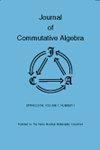未知的曲线,线的排列,以及雅可比矩阵关系的最小程度
IF 0.6
4区 数学
Q4 MATHEMATICS
引用次数: 3
摘要
我们利用对偶线排列AZ的定义方程的雅可比合集的最小度,重新表述了Cook, Harbourne, Migliore和Nagel关于P2中一组点Z的非预期平面曲线的存在性和不可约性的基本结果。给出了这种新方法的几种应用。特别地,我们证明了不可约的非预期五项只有在集合Z的基数等于11或12时才可能发生,并描述了这种情况发生的五种情况。本文章由计算机程序翻译,如有差异,请以英文原文为准。
UNEXPECTED CURVES IN ℙ2, LINE ARRANGEMENTS, AND MINIMAL DEGREE OF JACOBIAN RELATIONS
We reformulate a fundamental result due to Cook, Harbourne, Migliore and Nagel on the existence and irreduciblity of unexpected plane curves of a set of points Z in P2, using the minimal degree of a Jacobian syzygy of the defining equation for the dual line arrangement AZ . Several applications of this new approach are given. In particular, we show that the irreducible unexpected quintics may occur only when the set Z has the cardinality equal to 11 or 12, and describe five cases where this happens.
求助全文
通过发布文献求助,成功后即可免费获取论文全文。
去求助
来源期刊

Journal of Commutative Algebra
MATHEMATICS-
CiteScore
0.80
自引率
16.70%
发文量
28
审稿时长
>12 weeks
期刊介绍:
Journal of Commutative Algebra publishes significant results in the area of commutative algebra and closely related fields including algebraic number theory, algebraic geometry, representation theory, semigroups and monoids.
The journal also publishes substantial expository/survey papers as well as conference proceedings. Any person interested in editing such a proceeding should contact one of the managing editors.
 求助内容:
求助内容: 应助结果提醒方式:
应助结果提醒方式:


